Past and Present: The Borough Park Clubhouse
A look at Brooklyn, then and now. William H. Reynolds was a developer like no other before or since. During the course of his life, he cut a swath through Brooklyn, Queens, Long Island and Manhattan, developing new neighborhoods right and left. He also managed to become New York State’s youngest State Senator, the mayor…
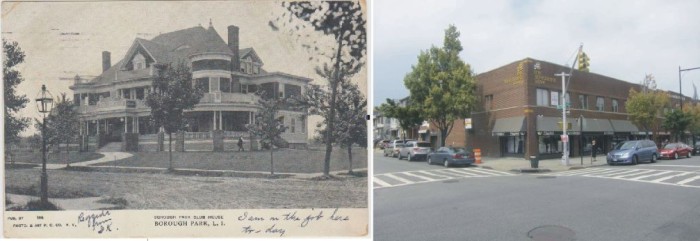

A look at Brooklyn, then and now.
William H. Reynolds was a developer like no other before or since. During the course of his life, he cut a swath through Brooklyn, Queens, Long Island and Manhattan, developing new neighborhoods right and left. He also managed to become New York State’s youngest State Senator, the mayor of Long Beach, Long Island, the owner of Dreamland Amusement Park, and a convicted felon. Not to mention his expertise in the manly art of fisticuffs and other athletic competitions.
Here in Brooklyn, by the turn of the 20th century, he was finishing up his extensive development of Prospect Heights. He had purchased a great deal of land cheap from the city; land left over when Prospect Park was laid out. He proceeded to build hundreds of handsome row houses there, and by 1895, most of them had already been sold. He needed a new project.
He found it in the old Dutch town of New Utrecht. Hundreds of acres of farmland were now being developed here in this southwestern part of Brooklyn, and Reynolds bought up most of it. He carved it up into 4,000 lots, sold some of it to other developers, and went to work on the rest. The beginnings of a new neighborhood were already there. In 1887, developer Electus B. Litchfield established a small cottage community called Blythebourne. There were only a few streets with houses on it, but it was enough for the nucleus of a new community.
Reynolds built around it. Blythebourne was a bit too English chichi, so the ex-senator called his community Borough Park. He also had the juice to make sure the community was served by a train station on the Brooklyn, Bath, and Coney Island West End line. The community had a small town feel, with detached suburban houses with wide front porches. Reynolds’ blocks had a mixture of large higher end homes in the popular Queen Anne and Colonial Revival styles of the day, but was mostly blocks of smaller wood framed suburban homes, very similar to nearby Flatbush. He even used the same architects. He had one of them build a house for himself on 49th Street and 15th Avenue.
If you look at the ads in the papers, it looked as if Reynolds and his chief competition, a builder named Edward Johnston, were dueling out house by house in Borough Park. The fact was the Johnston was actually Reynolds’ builder, and the friendly “competition” was a marketing ploy to sell houses. They had it all worked out, and both were happy. Reynolds also had a popular ad campaign offering a free house to any buyer who would bet against the outcome of the 1900 presidential election. His candidate won, so he never gave away anything. He did sell a lot of houses. He was a very canny businessman, and not above some moral ambiguity, as time would later show.
William Reynolds knew that nice houses were only part of a successful community. One also needed commercial blocks, with stores and amenities, houses of worship and social gathering spaces. Everyone likes the exclusivity of a good club, so Reynolds saved an entire block front plot of land on 13th Avenue between 50th and 51st Streets, and had a large Queen Anne/Colonial Revival clubhouse built, which he owned, and called the Borough Park Clubhouse. It was in the center of town, close to transportation and easy to get to.
The club was designed in 1898 by Benjamin Dreisler, a prominent Brooklyn architect whose work can be found mostly in Flatbush. He designed hundreds of houses there, including row houses in Prospect Lefferts Gardens and suburban houses in Prospect Park South, Ditmas Park, Midwood, and other parts of what is today called Victorian Flatbush. The building is a combination of two styles. It’s got Colonial Revival ornament and materials, and probably had very classical Revival décor inside, but the body of the house was pure Queen Anne, with lots of massing of shapes, the turret and tower, wrap around porch and dormered gables. The grounds of the club included an athletic field for baseball and other sports. “Billy” Reynolds loved to play with the club team.
After the Clubhouse opened, it became a popular venue for many different organizations within Borough Park. The newspapers are full of announcements and reports from all the different group activities, fund raisers, banquets and parties. There were fraternal organizations, church and synagogue groups, scouts, teachers, sports clubs, social clubs, music clubs and theater groups, union organizations and political clubs. Everyone in Borough Park used the Clubhouse.
After William Reynolds finished his development here, he moved on. His latest toy was a little amusement park in Coney Island called Dreamland. He was also working on Douglaston in Queens, and had his eye on a sleepy town called Long Beach, out on Long Island. He sold the club and forgot all about Borough Park. Borough Park always had a large Jewish population; Eastern European Jews started moving to the area as early as 1904-1905. There was also a large Irish and Italian population which centered on several Catholic churches.
The Borough Park Club existed until after World War II. The end of the war brought thousands of Orthodox and Hasidic Jews into the community, many of them refugees from the camps and pogroms of Europe. The old Borough Hall clubhouse first became a Jewish center, and then became a school – Yeshiva Etz Chaim. They removed the handsome wrap around porch and built two story wings on either side of the building. The grass was paved over and a large fence put up around the property.
Borough Park continued to grow into one of the largest Jewish communities outside of Israel. Today, they are overwhelmingly Orthodox and the Ultra-Orthodox Satmar Hasidim. Due to increasing numbers, the yeshiva moved elsewhere, and in the 1980s, the old clubhouse was torn down and replaced by Salomon Plaza, a two story strip mall type arrangement of stores. Most of the original buildings in Borough Park are now gone, replaced by newer, larger buildings. William Reynolds would not recognize his town at all.
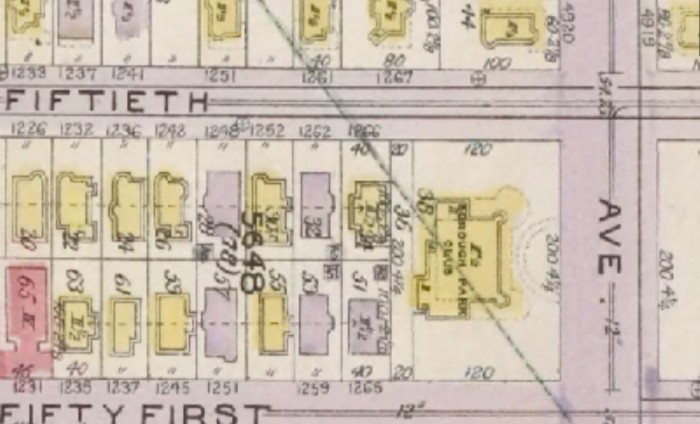
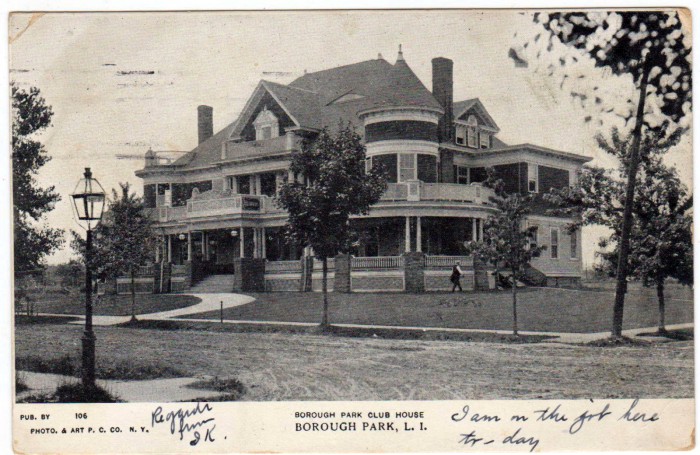
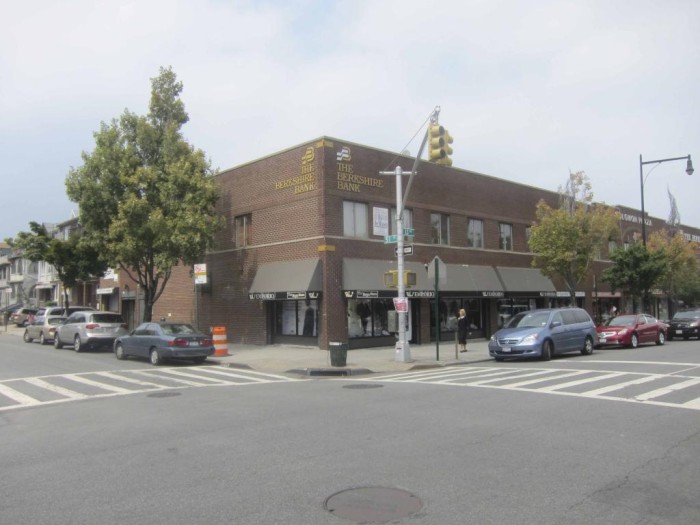
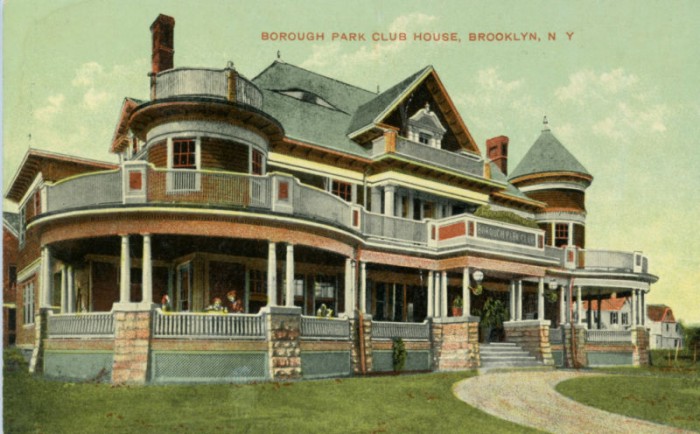
Related Stories
The Bikers, Singers, Athletes or Riders? Which Long-Gone Social Club Would You Join?
Past and Present: The Great Kings County Wheelmen’s Club
Past and Present: The 6th Assembly District Democratic Club









R.H. Kutner was the genial proprietor of The Borough Park Clubhouse in 1907. Prior to this he was managing the clubhouse with his wife for six years. In 1907 the clubhouse underwent extensive alterations and improvements, to which Kuttner “spared no expense making his establishment complete in every detail”. Additions included a bowling alley in the basement, a billiard parlor and a dancing stage among other things. There is no mention of Kuttner in this article only Reynolds, however newspaper from December 25th, 1907 have all this information, as this was the case. I’m wondering then, did Reynolds buy the clubhouse and sell it to Kutner or in the reverse, did Reynolds buy it from Kutner? This I do not know.
“R.H. Kutner” (one “t”)